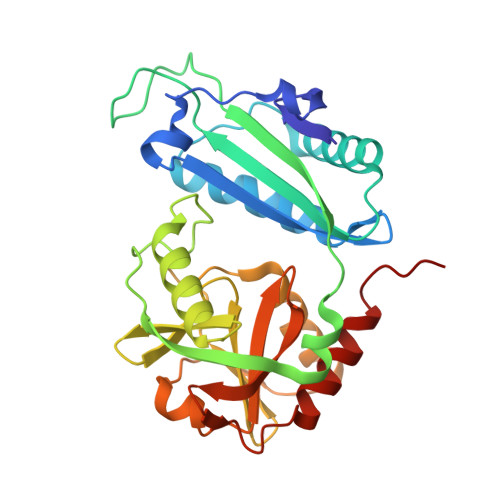Chiral discrimination among aminotransferases: inactivation by 4-amino-4,5-dihydrothiophenecarboxylic acid.
Lepore, B.W., Liu, D., Peng, Y., Fu, M., Yasuda, C., Manning, J.M., Silverman, R.B., Ringe, D.(2010) Biochemistry 49: 3138-3147
- PubMed: 20192272
- DOI: https://doi.org/10.1021/bi902052x
- Primary Citation of Related Structures:
3LQS - PubMed Abstract:
Mechanism-based inhibitors such as cycloserine and gabaculine can inactivate aminotransferases via reactions of the compounds with the pyridoxal phosphate cofactor forming an irreversible adduct. The reaction is chirally specific in that any one enzyme usually only recognizes one enantiomer of the inactivator. For instance, l-aspartate aminotransferase (l-AspAT) is inactivated by 4-amino-4,5-dihydro-2-thiophenecarboxylic acid (ADTA), however, only by the S-isomer. We have now shown that d-amino acid aminotransferase (d-a-AT) is irreversibly inactivated by the R-isomer of the same compound. The X-ray crystal structure (PDB code: 3LQS ) of the inactivated enzyme shows that in the product the enzyme no longer makes a Schiff base linkage to the pyridoxal 5'-phosphate (PLP) cofactor, and instead the compound has formed a derivative of the cofactor. The adduct is similar to that formed between d-cycloserine and d-a-AT or alanine racemase (Ala-Rac) in that the thiophene ring of R-ADTA is intact and seems to be aromatic. The plane of the ring is rotated by nearly 90 degrees with respect to the plane of the pyridine ring of the cofactor, in comparison with the enzyme inactivated by cycloserine. Based on the structure of the product, the mechanism of inactivation most probably involves a transamination followed by aromatization to form an aromatic thiophene ring.
Organizational Affiliation:
Graduate Program in Bioorganic Chemistry, Graduate Program in Biophysics and Biochemistry, Department of Biochemistry, Brandeis University, Waltham, Massachusetts 02454-9110, USA.
















